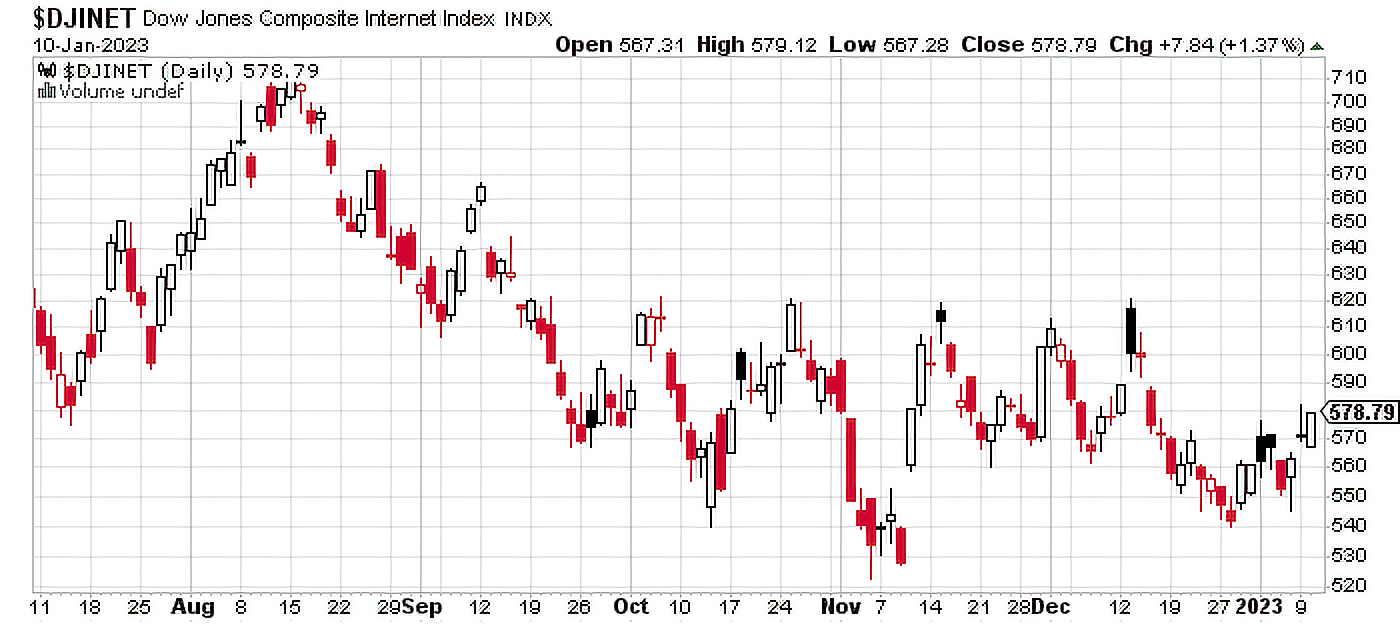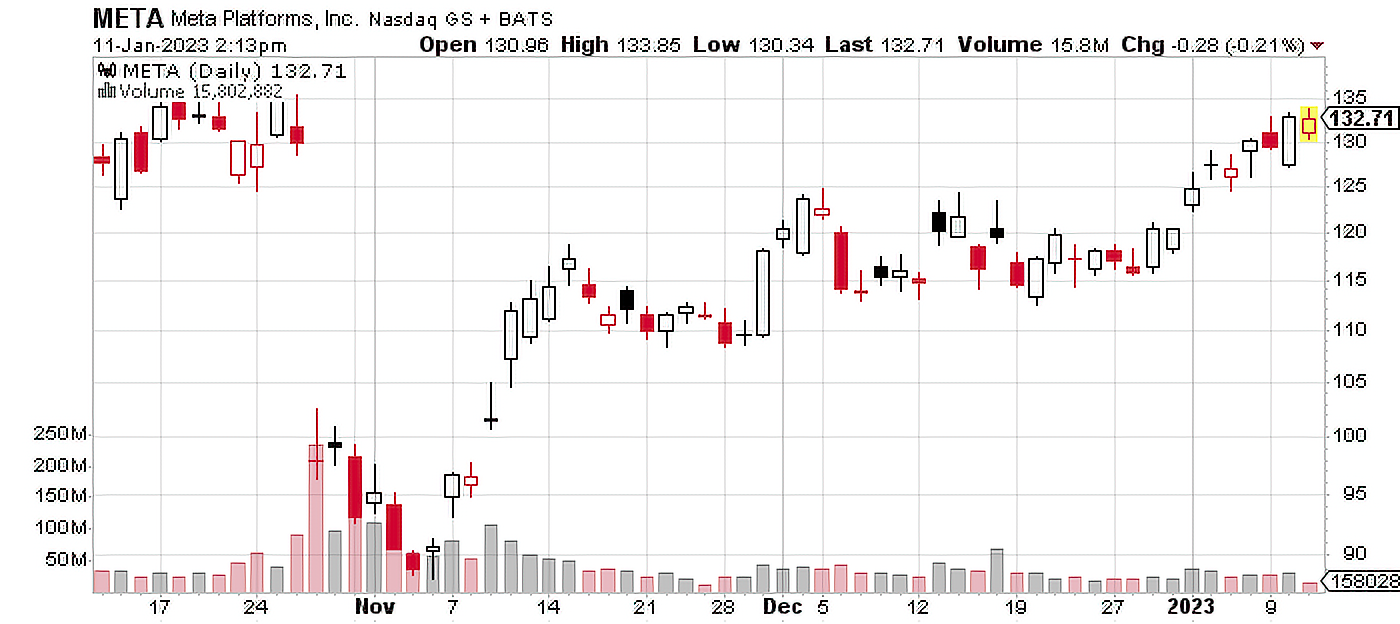Editor’s note: Any and all references to time frames longer than one trading day are for purposes of market context only, and not recommendations of any holding time frame. Daily rebalancing ETFs are not meant to be held unmonitored for long periods. If you don’t have the resources, time or inclination to constantly monitor and manage your positions, leveraged and inverse ETFs are not for you.
Internet stocks haven’t had an easy ride as of late. They took it on the chin in December, falling in sympathy with other tech stocks. But in recent weeks, shares of these companies have come back to life. Certainly no one is calling for internet stocks to party like it’s 1999 but at this level, could a decent short-term rally be at hand?
Source: StockCharts.com, January 10, 2023.
Candlestick charts display the high and low (the stick) and the open and close price (the body) of a security for a specific period. If the body is filled, it means the close was lower than the open. If the body is empty, it means the close was higher than the open.
The performance data quoted represents past performance. Past performance does not guarantee future results. The investment return and principal value of an investment will fluctuate. An investor’s shares, when redeemed, may be worth more or less than their original cost; current performance may be lower or higher than the performance quoted. For the most recent month-end performance go to Direxion.com/etfs. For standardized performance click here.
Internet Stocks: All Grown Up
For some traders, internet stocks may call to mind the fly-by-night IPOs (initial public offerings)* of the dot-com bubble but the components of today’s Dow Jones Composite Internet Index* are actually more of the household name variety. For example, Amazon.com, Inc. (NASDAQ: AMZN) [9.22%], Meta Platforms, Inc. (NASDAQ: META) [6.17%], Class A Alphabet Inc. (NASDAQ: GOOGL) [5.03], and Salesforce, Inc. (NYSE: CRM) [4.88%] are the top five constituents in this Index (as of 12/31/22). Other large companies in the Index include PayPal Holdings, Inc. (NASDAQ: PYPL) [4.11%] and AirBnB, Inc. (NASDAQ: ABNB) [2.95%] so we’re not exactly talking small caps here.
Yearning for Earnings: Possible Upcoming Trading Catalysts
Traders playing either the bull or bear side of internet stocks may want to keep their eyes on upcoming earnings releases that can trigger big one-day swings in these already volatile stocks. Not only will these reports potentially move the shares of the companies in question—they may also set the tone for the sector as a whole.
Here are some to watch out for:
Amazon.com, Inc.: The Jeff Bezos-led behemoth looks set to report Q4 2022 earnings on February 2. Consensus earnings per share forecast is $0.17 for the quarter, and $0.69 for the year. Having recently cut thousands of employees, an earnings beat may give the market hope that the company’s prospects are better than the cost-cutting suggested.
Cisco Systems, Inc. (NASDAQ: CSCO): The digital communications conglomerate will report earnings around February 15. For the quarter, the market expects earnings of $0.76 per share. Of note, Cisco handily beat analyst expectations in the prior quarter, so a “repeat beat” ought to be music to the bulls’ ears.
Meta Platforms, Inc.: Unlike Cisco, Meta disappointed investors last quarter. The slumping company missed the market’s earnings forecast and investors punished the stock with a one-day decline of more than 20% in late November 2022. Currently, the consensus estimate is for $2.25/share, and the release is expected on February 1st. Whether the company beats or misses here will say a lot about its own efforts to cut costs, as well as the state of advertising on Facebook and Instagram.
Source: StockCharts.com, January 11, 2023.
Candlestick charts display the high and low (the stick) and the open and close price (the body) of a security for a specific period. If the body is filled, it means the close was lower than the open. If the body is empty, it means the close was higher than the open.
The performance data quoted represents past performance. Past performance does not guarantee future results. The investment return and principal value of an investment will fluctuate. An investor’s shares, when redeemed, may be worth more or less than their original cost; current performance may be lower or higher than the performance quoted. For the most recent month-end performance go to Direxion.com/etfs. For standardized performance click here.
Reversion to the Mean, or More Pain to Come?
2022 was not kind to investors in internet stocks or growth stocks in general for that matter. The Dow Jones Composite Internet Index fell sharply in the first half of the year and treaded water in the third and fourth quarter.
If you’re a bull with a glass-half-full mindset, mean reversion is likely top of mind especially given the dominance of growth and tech stocks for so many years before 2022. Even retracing half of last year’s losses could produce some serious potential gains for those on the long side. Technical traders will be watching the 625 level on the Index, which has been a tough ceiling to crack going back to October.
How to Play the Long Side
Adventurous risk-seeking traders can capture the potential upside in internet stocks with the Direxion Daily Dow Jones Internet Bull 3X Shares (WEBL), which seeks daily investment results, before fees and expenses, of 300% of the performance of the Dow Jones Internet Composite Index.
For bears, a break of November’s lows around 525 could open the door to further selling if bulls throw in the towel at that logical level. Just remember: Even though 2022 was a rough one for internet stocks, there’s no law that says mean reversion must happen.
How to Play the Short Side
Traders looking to profit from a potential downside in internet stocks can play it with the Direxion Daily Dow Jones Internet Bear 3X Shares (WEBS), which seeks daily investment results, before fees and expenses, of 300% of the inverse (or opposite), of the performance of the Dow Jones Internet Composite Index.
Originally published 24 January 2023.
For more news, information, and analysis, visit the Leveraged and Inverse Channel.
*Definitions
– An initial public offering (IPO) or stock launch is a public offering in which shares of a company are sold to institutional investors and usually also to retail investors. An IPO is typically underwritten by one or more investment banks, who also arrange for the shares to be listed on one or more stock exchanges.
– The Dow Jones Internet Composite Index (DJINETT) is provided by S&P Dow Jones Indices and includes companies that generate at least 50% of their annual sales/revenue from the internet as determined by the Index Provider. Additionally, each stock must have a minimum of three months’ trading history and a three month average market capitalization of at least $100 million. The Index consists of 40 stocks from two different sectors, internet commerce and internet services.
One cannot directly invest in an index.
Investing in a Direxion Shares ETF may be more volatile than investing in broadly diversified funds. The use of leverage by a Fund increases the risk to the Fund. The Direxion Shares ETFs are not suitable for all investors and should be utilized only by sophisticated investors who understand leverage risk, consequences of seeking daily leveraged investment results and intend to actively monitor and manage their investment.
An investor should carefully consider a Fund’s investment objective, risks, charges, and expenses before investing. A Fund’s prospectus and summary prospectus contain this and other information about the Direxion Shares. To obtain a Fund’s prospectus and summary prospectus call 646-291-8907 or visit our website at www.direxion.com. A Fund’s prospectus and summary prospectus should be read carefully before investing.
Direxion Shares Risks – An investment in each Fund involves risk, including the possible loss of principal. Each Fund is non-diversified and include risks associated with the Funds’ concentrating their investments in a particular industry, sector, or geography which can increase volatility. The use of derivatives such as futures contracts and swaps are subject to market risks that may cause their price to fluctuate over time. Risks of each Fund include Effects of Compounding and Market Volatility Risk, Leverage Risk, Market Risk, Counterparty Risk, Rebalancing Risk, Intra-Day Investment Risk, Other Investment Companies (including ETFs) Risk, and risks specific to the Information Technology Sector and Internet Company Industry. The market prices of internet securities tend to exhibit a greater degree of market risk and sharp price fluctuations than other types of securities as these securities may fall in and out of favor with investors rapidly, which may cause sudden selling and dramatically lower market prices. Additional risks include, for the Direxion Daily Dow Jones Internet Bull 3X Shares, Daily Index Correlation Risk, and for the Direxion Daily Dow Jones Internet Bear 3X Shares, risks related to Shorting and Cash Transactions, and Daily Inverse Index Correlation Risk. Please see the summary and full prospectuses for a more complete description of these and other risks of each Fund.
Distributor: Foreside Fund Services, LLC.










